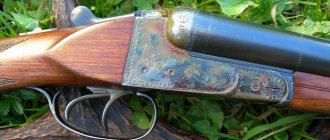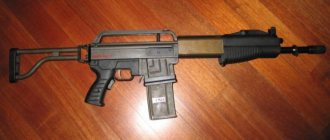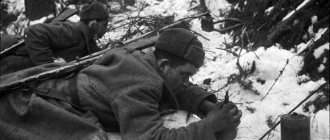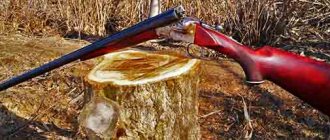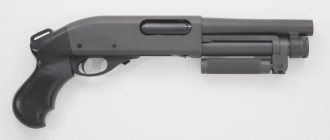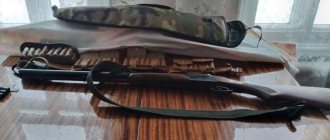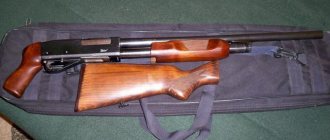IZH-54 is a popular gun among Soviet and Russian hunters. This type of double-barreled weapon was mass-produced at the Izhevsk Mechanical Plant from 1954 to 1970. Over almost 15 years of serial production, about half a million copies were produced, of which 70 thousand units were exported to countries near and far abroad.
The IZH-54 hunting rifle has proven itself to be a reliable and practical weapon. This allows him to be in sufficient demand among both experienced hunters and beginners. The owners speak fondly of the Soviet-made gun.
History of origin
After the victory in the Great Patriotic War, a large number of technical developments of German engineers were exported to the territory of the Soviet Union from Germany. Among the captured technologies were drawings and equipment from the German arms company JP Sauer und Sohn GmbH (Sauer & Sohn).
The design of the Sauer-8 rifle and the machines for its production helped to begin the serial production of the new Soviet hunting rifle IZH-49. Thus, the IZHMEX plant reached a higher quality level of shotgun production.
IZH-49 was produced from 1950 to 1954, after which it was decided to modernize this model, since it was heavy and not very well balanced.
After the modernization of the basic model IZH-49, a new development of the IZH-54 hunting rifle appeared. The improvements were introduced by small arms design engineer Leonid Ivanovich Pugachev. He made design changes, however, he chose to maintain the basic advantages.
The basis of the triple locking remains the same. The Anson-Delay internal trigger mechanism has changed, and updated sears have added durability to the design.
Other improvements helped the IZH-54 gun gain a reputation as a reliable and modern small arms. The modified design retained its Germanic roots.
Guns that have sunk into oblivion
I mostly walked the 65-year-long hunting trail hugging Izhevsk guns.
But the two guns that sunk into my soul and left a deep imprint in my memory were the IZH-54 and IZH-12. In this article, I would like to talk about some of the details of the creation of this gun, the features of its design, and share my impressions of hunting with the IZH-54-Sh2 custom gun, which I bought second-hand back in 1961.
Using equipment and technical documentation received from Germany as reparations, IzhMekh launched the production of a double-barreled shotgun based on the Sauer model with barrels located in a horizontal plane and with internal hammers. The gun was given the index IZH-49; it was produced mainly in 16-gauge, in smaller quantities in 12-gauge and in very limited quantities in 20-gauge.
During production and operation, shortcomings were identified in it that required the gun to be reworked. This work was successfully completed by design engineer L. Pugachev in collaboration with the head of the design bureau of double-barreled shotguns A. Klimov. This is how the IZH-54 12-gauge shotgun with internal hammers and horizontally connected barrels, well known to older generation hunters, appeared, produced from 1954 to 1969.
Design
The barrel blanks of the IZH-54 gun were made from 50A weapon steel. The metal alloy underwent thorough heat treatment and the barrels were immediately drilled out. This technology took a lot of time and labor costs were high, but the result was the highest quality of manufactured parts.
Over time, the labor-intensive technology was replaced with a simplified one, using the “hot forging” method, which led to a decrease in the quality of the guns produced.
Models produced from 1954 to 1960 had barrels soldered together with hard solder and interbarrel strips.
Since 1961, changes have been made to the connection technology. Now the barrels were attached to a coupling, which simplified installation and reduced the cost of the process. Brief characteristics of the barrel:
- caliber - 12, smoothbore;
- length 730 or 750 mm;
- chamber length 70mm;
- barrel channel diameter 18.5 mm and 18.9 mm;
- parabolic choke: right choke 0.5 mm and left full choke 1.0 mm.
The surface of the trunks was covered with one of the following compounds: chrome, nickel or a special layer of paint. The difference in surface treatment was small.
The only thing is that with chemical coating, the gloss looked duller and the resistance to high moisture was less than other methods of external processing of steel. This coating method was used throughout the 60s for all produced copies.
Until 1954, bores were not chrome-plated.
It was only in 1955 that chrome plating technology was first used. The processing process was selective, and only one-piece specimens were subjected to it. Information about the coating was not included in the gun's passport. Beginning in 1958, records of chrome plating began to appear in the document.
The block went through the following manufacturing process: all soft metal parts were fitted and then carburized. After which the parts assumed the required strength.
Varieties
The plant produces IZh smoothbore shotguns in a large number of model variations. In general, they differ in the number of trunks (one or two), and if there are two, then in the relative position of the trunks (horizontal or vertical).
Double-barreled shotguns with vertical barrels
IZH-59 was the first model with a vertical barrel arrangement, produced in Izhevsk. Their trunks were not yet soldered; couplings were responsible for their connection. The release mechanism is fixed on a separate base. The safety was non-automatic, but the possibility of a smooth release was provided.
The logical continuation of this gun was the modernized model IZH-12, in which the barrels were soldered, thereby correcting the main drawback of its predecessor, which was associated with the fact that the centers of the shot scree intersected. Today, one of the most recognizable “verticals” is the IZH-27, made on the basis of the IZH-12.
Horizontal arrangement of barrels for double-barreled guns
The first example of a horizontal plane was the IZH-41 model. The original design provides a universal release mechanism: two hooks, each of which works on its own barrel. This mechanism could be easily removed by pressing the locking button. The triggers were installed separately, and safety was ensured by a double locking mechanism for the barrels and an automatic safety lock.
Subsequently, models of hunting rifles IZH-52, 54, 58 and, finally, 43 were released. Their trigger mechanism was improved, design reliability and safety increased.
Appearance
The designers paid great attention to the quality of the weapon, so the aesthetic design of the gun remained below average. We tried to add beauty in the following way: stamps of animal images and simple patterns were applied to the metal plates. Technical information was applied by engraving.
To add individuality to the one-piece models, skilled craftsmen were hired to apply various engravings on the metal plates and on the butt. But this did not help rid the gun of its rough appearance.
Moreover, high-quality individual design by a master was very rare. There is an opinion among IZH-54 owners that engraving on a gun is generally inappropriate.
Gift copies were decorated at a high artistic level.
The decoration used the method of tauching with precious metals, gold and silver. The quality of the engraving was distinguished by its clarity and depth.
Decorated examples were classified as souvenirs, but this did not prevent them from having all the standard characteristics of small arms.
The IZH-54 hunting rifle has a classic butt design. It was made from walnut or oak. There was no difference in appearance. The characteristics were as similar as possible. Excellent wood processing technology allowed the stock to maintain its original appearance for many years.
It did not dry out or crack with any use. The stock is fitted to steel parts with high precision. It was equipped with pads in the form of a heel and a rosette on the pistol grip.
Ammunition used
For the IZH-54 shotgun, hunters and athletes use various types of 12-gauge cartridges, which differ significantly from each other. To make it easier to understand shooting ammunition, they are divided into three types:
- shotguns (standard, reinforced, sports)
- buckshot;
- bullets.
Shot charge
A larger cartridge caliber guarantees a larger number of pellets. The usual size of striking elements is from 1.5 to 5 mm. The 12 gauge cartridge is considered rather large and the recoil after the shot is very noticeable. The more powerful the recoil, the less accurate the hit. Recoil depends on the amount of gunpowder.
Purchased cartridges are more or less balanced in terms of the amount of shot and gunpowder. And when loading cartridges with shot on their own, professional hunters take into account that the large weight of the charge reduces its initial speed and firing distance.
Such ammunition can be used at close range. Well, and vice versa, respectively. However, too little shot dramatically reduces the chance of a hit. For this reason, most hunters adhere to the recommendations. Most, but not all. buckshot
Buckshot ammunition is loaded with shot from 5mm.
In this case, the fraction can be either consistent or inconsistent. In addition, the damaging elements can be soft or hard.
Soft shot is used for shooting at short distances, and hard shot is used for shooting at a distance. Depending on this, the hunter selects the optimal ammunition option.
Bullet
This type of ammunition is used for hunting large animals. Although for this it is better to use a rifled carabiner. But the hunt for large animals with an IZH-54 gun was and is ongoing. Depending on the size of the game, the bullet weight is selected.
The larger the animal, the correspondingly heavier the bullet. Its weight can reach up to 40 grams. A special feature of a bullet is its deformation when it hits an animal. To catch small game, lighter striking elements from 25 to 28 grams are used, which do not have the property of being deformed.
To shoot prey at a distance of 50-60 meters, a heavy caliber bullet with a belt is used. Its distinctive feature is its destructive power.
Ammo manufacturers
It is not even possible to select several companies producing 12-gauge cartridges with positive reviews. The products are in demand among regular customers, but there are also those who do not like the ammunition.
Each hunter chooses ammunition from a certain manufacturer for himself, based on personal use.
It can definitely be said that the quality of Russian cartridges is becoming competitive and in some cases superior to foreign analogues.
Meeting with an old friend
My friend Anatoly K. has an IZH-26 gun, which he acquired back in his distant years as a lieutenant, and he is satisfied with the performance of its parts and mechanisms to this day. But on this trip to the opening of the summer-autumn feather hunt, he often complained about his mistakes and began to suspect his faithful friend of losing his “anger.”
I suggested checking the firing of the gun on a 100-lobe target. Although the IZH-26 gun did not represent much of a mystery to me, I once again had the pleasure of assembling and disassembling it several times. This is the same IZH-54 gun only with some changes and additions to its design. It would seem that there is nothing special about it. But no matter what you say, my friends, when you pick up a gun made by IzhMekh after the war, you feel as if you have met an old acquaintance. The gun seemed to stick to his hands, and his eyes were caressed by the contours of the gun and the “outline” of the stock, the forearm and the pretty rosette on the neck of the butt. I am a long-time fan of Izhevsk rifles. I always wanted to know more about them, especially about post-war guns. Since I started hunting on my own in 1949 and I had the opportunity to see and acquire them.
When and by whom was it released?
The IZHMEH weapons company produced a fairly large number of modified IZH-54 models. Two types were production versions, and the rest were converted models.
The basic versions were the main type of gun. Basically, the entire production cycle was mechanized. Handwork was used to apply stamped images and drawings. The cost of the basic version was 90 rubles. Depending on the build quality, the price could reach up to 120 rubles for an IZH-54 gun.
Piece models were designated by the letter “Ш”. Its modified copies were designated as: Ш1 and Ш2. These one-off specimens had high-quality barrel alignment and excellent hit accuracy.
In addition, the weapon featured an exclusive design and engraving with images of birds and animals.
The forend and stock were made from valuable walnut species. The trigger module was plated with chrome.
The second basic version of the IZH-54 was a souvenir version of the gun. It was significantly distinguished by its handcrafted quality and individuality. The price for this type of weapon exceeded 200 rubles.
An experimental model of the IZH-54 shotgun with a 16-gauge barrel was produced in a very small batch. Today it is almost impossible to find this option.
The IZH-54 “Sport” is also a rare model. This modified specimen was manufactured to special orders and included two pairs of barrels of different lengths.
The good technical characteristics of the gun made it possible to begin export production of weapons. This type did not have expensive finishing. The inscriptions “Made in USSR” were written on the sides of the pads.
Izh-54: progressive regression
PHOTO SHUTTERSTOCK
Some argue that the basis for the design of both the IZH-54 and its predecessor should be sought in the captured and reparation German developments of JP Sauer und Sohn GmbH.
This explains some similarities between the products of the Izhevsk plant and their German counterparts.
IZH-54 was developed at the Izhevsk Mechanical Plant by Leonid Ivanovich Pugachev in the early 50s of the 20th century.
The new model has undergone many changes and innovations, but, unfortunately, not all of them have been implemented since the start of production.
The most important innovation was the operation of the fuse, which locked not the triggers, but the sear. The triggers became separate from the strikers.
In 1954, mass production of the IZH-54 began, and after some time chrome-plated screw-in fire tubes appeared on the forehead of the pad, and the barrels and chambers began to be chrome-plated.
In 1957, the IZH-54 received hammers with a release and was renamed IZH-57 in 16 gauge. And six years after the start of production, export deliveries of guns began.
| There were several versions of the IZH-54 gun. Photo by the author. |
During the period from 1954 to 1970, about 500 thousand copies were produced, more than 70 thousand of which traveled around the world.
IZH-54 was produced in both ordinary and piece versions. As for the pieces, there were the following options: IZH-54-Sh1, Sh and Sh2. They differed in the degree of accuracy: good accuracy, increased and very high, respectively. The remaining differences concerned the exterior decoration.
And if on Sh1 they simply improved the engraving and finishing by adding a colored edging to the rosette, then on Sh it wasn’t just a matter of colored edging. It is decorated with ornaments, figures of feathered game, and the trigger parts are chrome-plated. The nut, as well as for Ш2, was selected from the best varieties. Guns were also made as a gift, to suit the tastes of certain owners.
| Izh-54 had reliable triple locking. Photo by the author. |
The engraving on the copies that were exported was not particularly sophisticated: the images of the animals were removed, and instead the proud inscription “Made in USSR” was applied to the ornament.
The stocks were made of beech or walnut, they were both straight, English, and semi-pistol. Guns were sold in hunting stores, “Cult goods” and village stores, and could also be sent by mail.
The cost of a serial gun was around 100 rubles, while for a one-piece gun you would have to pay half, or even the entire salary of an average Soviet citizen - 170–250 rubles.
In addition to the hunting version, the IZH-54 “Sport” model was also produced. The gun, as a rule, was equipped with two barrels and, in terms of external design, was the same as a gift item, only for high-ranking persons who imagined themselves to be athletes. It had characteristic “wings” along the edges of the block and bevels on the receiver block.
However, the “Sport” model was so rare that few could boast of having seen it, much less held it in their hands.
| The design of the butts differs slightly. Photo by the author. |
IZH-54 played a big role in the development of the Soviet arms industry in general and the Izhevsk arms plant in particular. This was the factory's first hammerless gun, produced in such a large series, and the first factory gun to be exported.
| IZH-54 is an excellent, classic hunting rifle. PHOTO SHUTTERSTOCK |
In front of me are two representatives of serial production of IZH-54. Both are serial. Both... This is where their similarities end and the game “Find the Differences” begins. Let's begin. Who will find more? Instance number one. 1962 The passport has not been preserved.
The year of manufacture is stamped on the left barrel cushion, in the same place as information about the choke and barrel diameter. Somewhat worn. The colored tracing paper on the receiver has been preserved in fragments, the bluing has become discolored in some places, and small scratches have appeared on the wood (beech), which is not surprising after so many years.
Instance number two. Judging by the passport, this is an export version. Accepted by Quality Control Department in October 1968, and four months later sold for 109 rubles, which is more expensive than a regular serial one. On the barrel pads there is no information about the narrowing and diameter of the channels. This can probably be considered the first difference.
| The pads had the same design, but different sizes. Photo by the author. |
Second difference. The first copy was assembled on a demi-block (until 1963 it was assembled this way). The barrel tubes were made with an allowance, from which the barrel cushions were then made along with the hook halves.
These halves were soldered and strips were soldered to them. The fine seam from the breech to the bottom strap is a distinctive feature of this example. Taking into account the manufacturing method and grade of steel, the barrel block turned out to be extremely durable.
The second copy is assembled on couplings. The barrel tubes are pressed into a coupling, which is milled together with the hooks. The strips are soldered on top and bottom. A sure sign of such an assembly is the embossed seams around the barrels, spaced a palm's width from the breech cut.
The technology of assembling barrels on couplings was first tested on the IZH-57. The IZH-57 itself was an attempt to make a gun of the technological level of the IZH-54, but for the 16-gauge, which was more common in those years.
| The different performances were quite different from each other. Photo by the author. |
There is no clear answer to the main question that arose with the advent of the IZH-54 model and, probably, there never will be. After all, in the Soviet Union of those years, the 16th caliber reigned supreme, and all common models of hunting rifles were in this caliber.
IZH-54 was initially developed and throughout its production life (16 years) it was produced only in 12 gauge, without options. By the way, IZH-54 can be compared with GAZ-21.
| PHOTO SHUTTERSTOCK |
True, the Volga began to be produced not in 1954, but two years later, but this is the only difference. The rest is similar. The same production series, design that changes during the production process, external solidity and even pomp, a considerable share of manual labor, the desire to do the best, based on what production capabilities allow. And leaving the stage in 1970. And they are still admired, even two generations after the last copy was published.
The first batch of 57s was assembled using the usual technology, with demi-block barrels. But it was not easy to produce two rather complex models in parallel. If the blocks of the 54th and 57th had a high degree of unification, then with the barrel blocks everything was more complicated.
| The trunks differed not only in length and weight, but also in design. Photo by the author. |
And in the next batch of IZH-57, the barrel blocks were assembled using a different technology, which initially seemed like a workaround, but became relevant for all subsequent domestic mass-produced shotguns. The fight against excesses, it seems, took place not only in the area of architecture, but also affected weapons production, because even within the framework of one model of a high technical level, everything was simplified for the sake of reducing costs.
The IZH-57 was not produced for long and soon disappeared from the scene, giving way to the IZH-58 model, introduced in 1958. There is still a conversation about this popular model; this is an example of how a gun was carefully oriented and carefully adjusted to the needs of the main circle of owners.
With the IZH-54, everything was the other way around: a technically complex gun increased the knowledge and skill of its owners.
Yes, the general improvement of technology has not spared the IZH-54. In addition to the sleeved barrels, the configuration and size of the barrel shank, into the hole of which the Griner bolt entered, changed. The bolt became thinner and the shank decreased in size.
At the same time, the barrel tubes became of standard length - both for the horizontal IZH-54 and the vertical IZH-12. And for the IZH-26, which replaced the IZH-54 in 1970, the length became 730 mm.
The barrel block on the breech side has decreased in width by almost 2 mm, gaining less than 300 g in weight.
| It turned out that the barrels were not interchangeable within the same model. Photo by the author. |
If we take the appearance of these two guns, then they also saved on it. There is no longer a star on the butt plate and rosette of the grip of clutch guns, but a beautiful export inscription in a foreign language has appeared.
I dare to suggest that from this time the decline in the level of production of civilian weapons began. However, the 54th model was not seriously damaged, and the block was practically undamaged.
It was "robbed" later by replacing the Griner bolt as the third locking point with a Britt stop and Westley-Richards rotary key locking. At the same time, they launched a version with ejectors.
The decline was evident in literally everything. But, despite everything, the IZH-54 still remains one of the most high-tech and reliable Soviet guns.
Diana Ivanova August 23, 2022 at 11:16 am
Owner reviews
The IZH-54 smoothbore gun has positive reviews from its owners. They claim that in most cases the gun never failed. However, there were funny situations. One of the hunters said that when he was hunting hares in winter, the weapon began to fire double shots.
The recoil was so strong that the shooter's shoulder was knocked off and his lip was broken.
Returning home, he disassembled the block. The cause was discovered immediately. It turned out that the lubricant of the striking mechanism had thickened and did not allow the trigger to move into place. By removing the excess lubricant, the problem was solved.
More than half a century has passed since the start of production of the IZH-54, and interest in it has not waned, on the contrary, it has grown. It’s difficult to say what this is connected with, but it’s worth assuming that hunters are attracted to Soviet quality. The price for them is still quite high, and this is after 60 years of operation.

